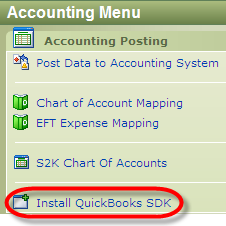

#RUBY QB SDK PASSWORD#
rbenv-gemset(s) file for gemsets changes inspection is enabled to be able to use this quick-fix.If you already have a QBO account you can use your username and password to join as a developer. The gemset will be disabled for the current SDK. This gemset will be shown as the child of the current SDK: Use the Create ‘name’ quick-fix to create a gemset: Type the required gemset name on a separate line. rbenv-gemsets file.įurthermore, you can create and disable gemsets right in the editor: For instance, if you uncheck the gemset in Ruby SDK and Gems, the corresponding record will be removed from the. RubyMine synchronizes the gemsets enabled in the Ruby SDK and Gems page with the ones specified in. rbenv-gemsets file manages project gemsets. RubyMine enables you to work with rbenv gemsets using the rbenv-gemsets plugin. This project will use the created gemset for its gems. On the New Project page, click the Create link next to the Use gemset 'project_name' checkbox:Īfter the gemset has been created, make sure that the Use gemset 'project_name' checkbox is enabled. Start creating a new project as described in Create and run your first Ruby project. You can create an RVM gemset on project creation. To create it, click Apply or OK in the Settings/Preferences dialog. This means that gemset is not created yet. Note that the asterisk is appended to the gemset name. The Ruby SDK and Gems page will show the gemset as a child of the selected SDK: Then, specify the gemset name and click OK: In the dialog that opens, select the Ruby SDK, for which the gemset will be created. Right-click the required interpreter and select New RVM gemset To create an RVM gemset in the Settings/Preferences dialog Ctrl+Alt+S, go to the Language & Frameworks | Ruby SDK and Gems page and perform the following steps: Create RVM gemsets Create a gemset for an existing project However, you can use the Terminal for this purpose. To avoid deleting any vital information from your machine, RubyMine doesn't allow you to remove gemsets from the UI.
#RUBY QB SDK HOW TO#
See Install gems for instructions on how to install gems.


In this case, gems will be installed to the first enabled gemset. On the other hand, the rbenv version manager provides the ability to select several gemsets for a project: On this page, the gemsets are shown as the interpreter children:įor RVM, you can select a certain gemset and install project gems to this gemset. To see gemsets available for the installed interpreters, open the Settings/Preferences dialog Ctrl+Alt+S and go to the Language & Frameworks | Ruby SDK and Gems page. Note that this functionality is supported only for local interpreters. RubyMine provides the capability to work with gemsets for the RVM and rbenv version managers.


 0 kommentar(er)
0 kommentar(er)
